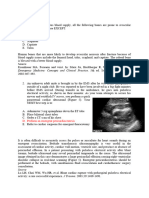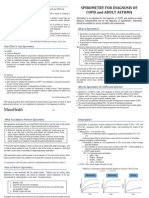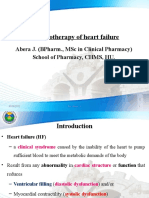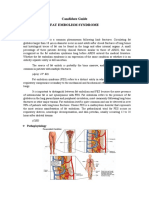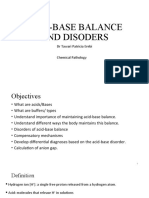0 ratings0% found this document useful (0 votes)
32 viewsHeart Failure
Heart Failure
Uploaded by
galemayehu471The document defines heart failure and discusses its epidemiology, etiology, pathophysiology, clinical features, investigations, management, and cor pulmonale. Heart failure results from impaired ventricular filling or ejection and leads to symptoms like dyspnea and fatigue. It affects millions worldwide and risk increases with age.
Copyright:
© All Rights Reserved
Available Formats
Download as PPTX, PDF, TXT or read online from Scribd
Heart Failure
Heart Failure
Uploaded by
galemayehu4710 ratings0% found this document useful (0 votes)
32 views80 pagesThe document defines heart failure and discusses its epidemiology, etiology, pathophysiology, clinical features, investigations, management, and cor pulmonale. Heart failure results from impaired ventricular filling or ejection and leads to symptoms like dyspnea and fatigue. It affects millions worldwide and risk increases with age.
Original Description:
Heart Failure
Original Title
HEART FAILURE
Copyright
© © All Rights Reserved
Available Formats
PPTX, PDF, TXT or read online from Scribd
Share this document
Did you find this document useful?
Is this content inappropriate?
The document defines heart failure and discusses its epidemiology, etiology, pathophysiology, clinical features, investigations, management, and cor pulmonale. Heart failure results from impaired ventricular filling or ejection and leads to symptoms like dyspnea and fatigue. It affects millions worldwide and risk increases with age.
Copyright:
© All Rights Reserved
Available Formats
Download as PPTX, PDF, TXT or read online from Scribd
Download as pptx, pdf, or txt
0 ratings0% found this document useful (0 votes)
32 views80 pagesHeart Failure
Heart Failure
Uploaded by
galemayehu471The document defines heart failure and discusses its epidemiology, etiology, pathophysiology, clinical features, investigations, management, and cor pulmonale. Heart failure results from impaired ventricular filling or ejection and leads to symptoms like dyspnea and fatigue. It affects millions worldwide and risk increases with age.
Copyright:
© All Rights Reserved
Available Formats
Download as PPTX, PDF, TXT or read online from Scribd
Download as pptx, pdf, or txt
You are on page 1of 80
HEART FAILURE
MULUALEM ALEMAYEHU ( MD,
INTERNIST, ASSISTANT PROFESSOR
OF MEDICINE)
OUTLINE
• DEFINITION
• ETIOLOGY
• PATHOPHYSIOLOGY
• CLINICAL FEATURES
• INVESTIGATIONS
• MANAGEMENT
DEFINITION
• a complex clinical syndrome that results from
structural or functional impairment of
ventricular filling or ejection of blood, which in
turn leads to the cardinal clinical symptoms of
dyspnea and fatigue and signs of HF, namely
edema and rales.
EPIDEMIOLOGY
• HF is a burgeoning problem worldwide, with more
than 20 million people affected.
• The overall prevalence of HF in the adult population
in developed countries is 2%.
• HF prevalence follows an exponential pattern, rising
with age, and affects 6–10% of people over age 65.
• relative incidence of HF is lower in women than in
men, yet women constitute at least one-half the
cases of HF because of longer life expectancy.
• Very little is known about the prevalence or
risk of developing HF in emerging nations
because of the lack of population-based
studies in those countries.
• Rheumatic heart disease remains a major
cause of HF in Africa and Asia, especially in the
young.
• Hypertension is an important cause of HF in
the African and African-American populations
• Chagas’ disease is still a major cause of HF in
South America.
• Anemia is a frequent concomitant factor in HF
in many developing nations.
• As developing nations undergo socioeconomic
development, the epidemiology of HF is
becoming similar to that of Western Europe
and North America, with CAD emerging as the
single most common cause of HF.
ETIOLOGY
• approximately one-half of patients who
develop HF have a normal or preserved EF (EF
≥50%).
ETIOLOGY
Classification of Heart Failure
ACCF/AHA Stages of HF NYHA Functional Classification
A At high risk for HF but without structural None
heart disease or symptoms of HF.
B Structural heart disease but without signs I No limitation of physical activity.
or symptoms of HF. Ordinary physical activity does not cause
symptoms of HF.
C Structural heart disease with prior or I No limitation of physical activity.
current symptoms of HF. Ordinary physical activity does not cause
symptoms of HF.
II Slight limitation of physical activity.
Comfortable at rest, but ordinary physical
activity results in symptoms of HF.
III Marked limitation of physical activity.
Comfortable at rest, but less than ordinary
activity causes symptoms of HF.
IV Unable to carry on any physical activity
D Refractory HF requiring specialized without symptoms of HF, or symptoms of
interventions. HF at rest.
ACUITY OF PRESENTATION
• ADHF
• CHRONIC HF
PATHOPHYSIOLOGY
Pathogenesis of heart failure with a
depressed EF
Activation of neurohormonal systems in HF
Overview of Left Ventricular Remodeling
COUNTERACTING NEUROHORMONES
Left Ventricular Remodeling
• changes in LV mass, volume, and shape and the
composition of the heart that occur after cardiac injury
and/or abnormal hemodynamic loading conditions.
• may contribute independently to the progression of HF by
virtue of the mechanical burdens.
• In addition to the increase in LV end-diastolic volume, LV
wall thinning occurs as the left ventricle begins to dilate.
• increase in wall thinning, along with the increase in
afterload created by LV dilation, leads to a functional
afterload mismatch that may contribute further to a
decrease in stroke volume.
PATHOGENESIS OF HFpEF
• understanding of the mechanisms that
contribute to the development of HF with a
preserved EF is still evolving.
• diastolic dysfunction was thought to be the
only responsible mechanism
• additional extracardiac mechanisms may be
important - increased vascular stiffness
- impaired renal function.
CLINICAL FEATURES
• FATIGUE
• DYSPNEA
• ORTHOPNEA
• PND
• Cheyne-Stokes respiration
Other Symptoms
• Gastrointestinal symptoms - Anorexia, nausea,
and early satiety associated with abdominal pain
and fullness are common
• right upper-quadrant pain.
• Cerebral symptoms such as confusion,
disorientation, and sleep and mood disturbances
may be observed in patients with severe HF.
• Nocturia is common in HF and may contribute
to insomnia
PHYSICAL EXAMINATION
• General Appearance and Vital Signs
• Jugular Veins
• Pulmonary Examination
• Cardiac Examination
• Abdomen
• Extremities
• Cardiac cachexia
.>
Diagnostic investigations
• complete blood count,
• urinalysis,
• serum electrolytes (including calcium and
magnesium)
• blood urea nitrogen, serum creatinine, glucose,
• fasting lipid profile,
• liver function tests, and
• thyroid-stimulating hormone.
ECG
• The ECG can be used firstly as a screening test to
assess the likelihood of HF and the need for
subsequent echocardiography to confirm or refute a
diagnosis.
• It is unusual for a patient with HF to have a normal
ECG, so it is a good tool to rule out HF.
• The ECG abnormalities reported in HF are all non-
specific, and relatively common in older patients.
• The specificity of an abnormal ECG is relatively poor
(around 60% at best).
- Electrocardiographic abnormalities in patients
with HF include:
• pathological Q waves
• left bundle branch block
• left ventricular hypertrophy (LVH)
• atrial fibrillation
• non-specific ST and/or T-wave changes.
BNP or N-terminal pro-B-type Natriuretic
peptide (NT-proBNP)
- useful to support clinical judgment for the diagnosis
of acutely decompensated HF, especially in the
setting of uncertainty for the diagnosis.
-In ambulatory patients with dyspnea, measurement
of BNP or (NT-proBNP) is useful to support clinical
decision making regarding the diagnosis of HF,
especially in the setting of clinical uncertainty.
- useful for establishing prognosis or disease severity
in chronic HF & ADHF.
• can be useful to achieve optimal dosing of
GDMT in select clinically euvolemic patients
followed in a well-structured HF disease
management program.
Causes for Elevated Natriuretic Peptide
Levels
Cardiac Noncardiac
Heart failure, including RV Advancing age
syndromes Anemia
Acute coronary syndrome Renal failure
Heart muscle disease, including Pulmonary causes: obstructive
LVH sleep apnea, severe pneumonia,
Valvular heart disease pulmonary hypertension
Pericardial disease Critical illness
Atrial fibrillation Bacterial sepsis
Myocarditis Severe burns
Cardiac surgery Toxic-metabolic insults, including
Cardioversion cancer chemotherapy and
envenomation
Chest x-ray
• to assess
- heart size
- pulmonary congestion
• to detect alternative cardiac, pulmonary, and
other diseases that may cause or contribute to
the patients’ symptoms
2 -dimensional echocardiogram with
Doppler
- should be performed during initial evaluation
of patients presenting with HF to assess
• Ventricular function & size
• Wall thickness
• Wall motion
• Valve function
OTHER Investigations
• Noninvasive imaging to detect myocardial
ischemia and viability is reasonable in HF and
CAD
• Radionuclide ventriculography
• MRI
Invasive Evaluation
• Monitoring with a pulmonary artery catheter
should be performed in patients with respiratory
distress or impaired systemic perfusion when
clinical assessment is inadequate
• When coronary ischemia may be contributing to
HF, coronary arteriography is reasonable
• Endomyocardial biopsy can be useful in
patients with HF when a specific diagnosis is
suspected that would influence therapy.
COR PULMONALE
DEFINITION
• often referred to as pulmonary heart disease,
can be defined as altered RV structure and/or
function in the context of chronic lung disease
and is triggered by the onset of pulmonary
hypertension.
• Although RV dysfunction is also an important
sequela of HFpEF and HFrEF, this is not
considered as cor pulmonale.
PATHOPHYSIOLOGY AND BASIC
MECHANISMS
• Although many conditions can lead to cor pulmonale,
the common pathophysiologic mechanism is pulmonary
hypertension that is sufficient to alter RV structure (i.e.,
dilation with or without hypertrophy) and function.
• In the setting of parenchymal lung diseases, primary
pulmonary vascular disorders, or chronic (alveolar)
hypoxia, the circulatory bed undergoes varying degrees
of vascular remodeling, vasoconstriction, and
destruction.
• As a result, pulmonary artery pressures and RV
afterload increase, setting the stage for cor pulmonale
ETIOLOGY
CLINICAL FEATURES
• Respiratory symptoms
• Features of right sided heart failure
Diagnosis
• Echocardiography
• BNP ,NT pro-BNP
• ECG
• CXR
• CT SCAN of lungs & vasculature
• Ventilation -Perfusion lung scan
• Spirometry and lung volumes
• Arterial blood gases
ACUTE DECOMPENSATED HEART
FAILURE
DEFINITION of ADHF
• the new onset or recurrence of symptoms and
signs of heart failure requiring urgent or
emergent therapy and resulting in seeking
unscheduled care or hospitalization.
• many patients may have a more subacute
course.
PATHOPHYSIOLOGY of AHF
• AHF is not a single disease but a
heterogeneous clinical syndrome.
• pathophysiology is-
- complex and highly variable
- many overlapping pathogenic mechanisms
that may be operative in a given clinical
scenario to a greater or lesser degree
Pathophysiologic Framework
• consider AHF as the result of the interaction of
- Underlying substrate
- Initiating mechanisms or triggers
- Amplifying mechanisms
HEMODYNAMIC PROFILE
Investigations in ADHF
MOST CONSISTENT PROGNOSTIC
MARKERS inADHF
• BLOOD PRESSURE
• BUN
• BNP & NT – BNP
MANAGEMENT OF HEART FAILURE
• Distinctive phenotypes of presentation with diverse
management targets exemplify the vast syndrome of
heart failure.
• These range from
1. chronic heart failure with reduced ejection fraction
(HFrEF)
2.heart failure with preserved ejection fraction
(HFpEF)
3.acute decompensated heart failure (ADHF)
4.advanced heart failure.
MANAGEMENT of Acute
Decompensated Heart Failure
(ADHF)
GOALS OF TREATMENT in ADHF
ALGORITHM FOR ADHF MANAGEMENT
TRIAGE FOR FURTHER CARE
- hospitalization is recommended for patients with
• evidence of severe decompensated heart failure,
including hypotension
• worsening renal function
• Altered mentation
• dyspnea at rest associated with either tachypnea
or hypoxemia (oxygen saturation <90%)
• Hemodynamically significant arrhythmia
• acute coronary syndromes
- Hospitalization should be considered
• in patients with worsened congestion, even in the
absence of dyspnea and often reflected by
significant weight gain (≥5 kg), other signs or
symptoms of pulmonary or systemic congestion
• newly diagnosed heart failure
• complications of heart failure therapy (such as
electrolyte disturbances, frequent implantable
cardioverter-defibrillator [ICD] firings)
• other associated comorbid conditions
Oxygen therapy and ventilatory support
• If oxygen saturation [SaO2] <90%), oxygen
administration is recommended.
• Patients may require NIV or Mechanical
ventlation
PHARMACOTHERAPY for Acute
Decompensated Heart Failure
• LOOP DIURETICS
• VASODILATORS
• INOTROPS & INODILATORS
• VASOPRESSORS
Intravenous loop diuretics
• symptomatic patients with objective evidence of
congestion consistent with pulmonary or systemic
venous hypertension or edema should receive urgent
diuretic therapy for rapid relief of dyspnea.
• Initial therapy typically consists of a bolus injection
with a dose between 1 and 2.5 times the patient’s
oral loop diuretic dose for patients on chronic diuretic
therapy
• Mainstay of treatment in AHF
• No good data regarding accurate dosing in AHF.
Typical doses of Diuretics in ADHF
VASODILATORS
• In the absence of hypotension, vasodilators
play an important role in the initial therapy of
patients with pulmonary edema and poor
oxygenation.
NITRATES
Inotropes and Inodilators
• increase cardiac output through cAMP-mediated
inotropy and reduce PCWP through vasodilation.
• retrospective data from both registries and trials of
AHF patients suggest that even the short term use
(hours to few days) of intravenous inotropes is
associated with ;
- significant side effects such as hypotension, atrial or
ventricular arrhythmias
- an increase in in-hospital and possibly long-term
mortality.
INOTROPIC & VASOPRESSOR AGENTS
INHOSPITAL PATIENT MONITORING
DISCHARGE CRITEREA
HEART FAILURE WITH REDUCED EJECTION
FRACTION
Pharmacologic Therapy & Target Doses in
Heart Failure with Reduced EF
NEUROHORMONAL ANTAGONISM
• ACEI
• BETA BLOCKERS
• ALDOSTERONE ANTAGONISM
ACEI
• Meta-analyses suggest a 23% reduction in
mortality and a 35% reduction in the
combination endpoint of mortality and
hospitalizations for heart failure in patients
treated with ACEIs.
Beta Blockers
• Patients treated with beta blockers provide a
further 35% reduction in mortality on top of
the benefit provided by ACEIs alone.
Dose and Outcome
• A trial has indicated that higher tolerated doses of
ACEIs achieve greater reduction in hospitalizations
without materially improving survival.
• Beta blockers demonstrate a dose-dependent
improvement in cardiac function and reductions in
mortality and hospitalizations.
• in the absence of symptoms to suggest hypotension
(fatigue and dizziness), pharmacotherapy may be up-
titrated every 2 weeks in hemodynamically stable
and euvolemic ambulatory patients as tolerated.
MINERALOCORTICOID ANTAGONISTS
• associated with a reduction in mortality in all stages of
symptomatic NYHA class II to IV HFrEF.
• Elevated aldosterone levels promote sodium retention, electrolyte
imbalance, and endothelial dysfunction and may directly
contribute to myocardial fibrosis.
• The selective agent eplerenone (tested in NYHA class II and post–
myocardial infarction heart failure) and the nonselective
antagonist spironolactone (tested in NYHA class III and IV heart
failure) reduce mortality and hospitalizations, with significant
reductions in sudden cardiac death (SCD).
• Hyperkalemia and worsening renal function are concerns,
especially in patients with underlying chronic kidney disease, and
renal
ARTERIOVENOUS VASODILATION
• The combination of hydralazine and nitrates has been
demonstrated to improve survival in HFrEF.
• Hydralazine reduces systemic vascular resistance and
induces arterial vasodilatation by affecting intracellular
calcium kinetics; nitrates are transformed in smooth
muscle cells into nitric oxide, which stimulates cGMP
production and consequent arterial-venous vasodilation.
• This combination improves survival, but not to the
magnitude evidenced by ACEIs or ARBs.
• is preferred as a disease- modifying approach in individuals
with HFrEF unable to tolerate RAAS–based therapy
• A trial conducted in self-identified African Americans,
the African-American Heart Failure Trial (A-Heft),
studied a fixed dose of isosorbide dinitrate with
hydralazine in patients with advanced symptoms of
HFrEF who were receiving standard background
therapy.
• The study demonstrated benefit in survival and
hospitalization recidivism in the treatment group.
• Adherence to this regimen is limited by the thrice-
daily dosing schedule.
CARDIAC RESYNCHRONIZATION THERAPY
• Non synchronous contraction between the walls of the
left ventricle (intraventricular) or between the ventricular
chambers (interventricular) impairs systolic function,
decreases mechanical efficiency of contraction, and
adversely affects ventricular filling
• Mechanical dyssynchrony results in an increase in wall
stress and worsens functional mitral regurgitation.
• The single most important association of extent of
dyssynchrony is a widened QRS interval on the surface
electrocardiogram, particularly in the presence of a left
bundle branch block pattern
SUDDEN CARDIAC DEATH PREVENTION IN
HEART FAILURE
• SCD due to ventricular arrhythmias is the mode of death in
approximately half of patients with heart failure and is particularly
proportionally prevalent in HFrEF patients with early stages of the
disease.
• Patients who survive an episode of SCD are considered to be at
very high risk and qualify for placement of an implantable
cardioverterdefibrillator (ICD).
• Although primary prevention is challenging, the degree of
residual left ventricular dysfunction despite optimal medical
therapy (≤35%) to allow for adequate remodeling and the
underlying etiology (post–myocardial infarction or ischemic
cardiomyopathy) are the two single most important risk markers
for stratification of need and benefit.
Indications for ICD
• patients with NYHA class II or III symptoms of
heart failure and an LVEF <35%, irrespective of
etiology of heart failure, are appropriate
candidates for ICD prophylactic therapy.
• patients with a myocardial infarction and
optimal medical therapy with residual LVEF
≤30% (even when asymptomatic).
EXERCISE
• The Heart Failure: A Controlled Trial Investigating Outcomes of
Exercise Training (HF-ACTION) study investigated short-term (3-
month) and long-term (12-month) effects of a supervised
exercise training program in patients with moderate HFrEF.
• Exercise was safe, improved patients’ sense of well-being, and
correlated with a trend toward mortality reduction.
• Maximal changes in 6-minute walk distance were evident at 3
months with significant improvements in cardiopulmonary
exercise time and peak oxygen consumption persisting at 12
months.
• Therefore, exercise training is recommended as an adjunctive
treatment in patients with heart failure.
TREATMENTS WITH UNPROVEN BENEFIT
• CALCIUM CHANNEL ANTAGONISTS
• ANTI – INFLAMMATION AGENTS
• STATINS
• ANTICOAGULATION AND ANTIPLATELET THERAPY
• FISH OIL
• MICRONUTRIENTS
• ENHANCED EXTERNAL COUNTERPULSATION
(EECP)
ADVANCED THERAPIES
• Cardiac Transplantation
• Prolonged Assisted Circulation
TREATMENT OF HFpEF
• Long term treatments that change the
outcome not yet available.
• Treatment of underlying etiology.
You might also like
- Respiratory Assessment ChecklistDocument3 pagesRespiratory Assessment Checklistvishnu100% (12)
- Heart Failure Topic DiscussionDocument11 pagesHeart Failure Topic Discussionapi-665372449100% (1)
- Concept Map - F and EDocument1 pageConcept Map - F and EAbigail LonoganNo ratings yet
- 2013 Sepsis GuidelinesDocument58 pages2013 Sepsis GuidelinesMuhd Azam100% (1)
- The Management of DVT: Dr. Heru Sulastomo, SP - JP (K), FIHA Dr. Ahmad Yasa', SP - JP, FIHA, MkesDocument19 pagesThe Management of DVT: Dr. Heru Sulastomo, SP - JP (K), FIHA Dr. Ahmad Yasa', SP - JP, FIHA, MkesDEWI MULYANINo ratings yet
- MCQ On Anatomy & PhysiologyDocument5 pagesMCQ On Anatomy & PhysiologySivasankaran GovindasamyNo ratings yet
- Heart FailureDocument32 pagesHeart FailureDeepak KarthikeyanNo ratings yet
- Heart FailureDocument57 pagesHeart FailurenewtypeNo ratings yet
- Heart FailureDocument11 pagesHeart Failureppp997412No ratings yet
- Heart FailureDocument9 pagesHeart Failuresam2000samNo ratings yet
- Referat HipertensiDocument60 pagesReferat HipertensiSitty AchmadNo ratings yet
- Stroke Physician: Discharge ChecklistDocument4 pagesStroke Physician: Discharge ChecklistEllaNo ratings yet
- Pancoast TumorDocument26 pagesPancoast TumorDhanis HastinNo ratings yet
- Myasthenia Gravis Anesthetic Implications and ManagementDocument31 pagesMyasthenia Gravis Anesthetic Implications and Managementaashish45No ratings yet
- Myasthenia GravisDocument4 pagesMyasthenia Gravishollyu100% (1)
- Adrenal DisordersDocument32 pagesAdrenal DisordersJyoti ChadhaNo ratings yet
- Krok 2024 Updated All QuestionsDocument29 pagesKrok 2024 Updated All Questionshdidoumeryam09100% (1)
- Arab Board Exam 2 With AnswersDocument31 pagesArab Board Exam 2 With Answersahmed.farag.ali2020No ratings yet
- Airway Obstruction - Types, Causes, and SymptomsDocument6 pagesAirway Obstruction - Types, Causes, and SymptomsGilbertLiem100% (1)
- Acute Heart FailureDocument9 pagesAcute Heart FailureChen Briones100% (1)
- Spiro Me Try Cheat Sheet 09Document2 pagesSpiro Me Try Cheat Sheet 09Yudha Perwira PutraNo ratings yet
- Occupational DZDocument102 pagesOccupational DZRamon MonchoNo ratings yet
- MCQDocument136 pagesMCQRahul Patil100% (1)
- Heart Failure: Marvick F. Galima RNDocument42 pagesHeart Failure: Marvick F. Galima RNSheng GosepNo ratings yet
- Tachyarrhythmias ECGDocument38 pagesTachyarrhythmias ECGali talaat100% (1)
- TLS FinalDocument69 pagesTLS FinalGrace Arthur100% (1)
- Meninges - Steven McGee - Evidence-Based Physical Diagnosis-Elsevier (2017)Document8 pagesMeninges - Steven McGee - Evidence-Based Physical Diagnosis-Elsevier (2017)Victor MejiaNo ratings yet
- Arnold Chiari Malformation & SyringomyeliaDocument38 pagesArnold Chiari Malformation & SyringomyeliaBojan PavlovicNo ratings yet
- Oncological EmergencyDocument80 pagesOncological Emergencybonsazewdie2883No ratings yet
- Acute Pulmonary Edema - Nitrate or Diuretic Dr. Heny Martini, SPJP (K) PDFDocument50 pagesAcute Pulmonary Edema - Nitrate or Diuretic Dr. Heny Martini, SPJP (K) PDFmgoez077No ratings yet
- Tuberculosis: Communicable DiseaseDocument6 pagesTuberculosis: Communicable DiseaseMiguel Cuevas DolotNo ratings yet
- Anaphylatic and Neurogenic ShockDocument57 pagesAnaphylatic and Neurogenic ShockAhmedNo ratings yet
- HEMOPTYSISDocument37 pagesHEMOPTYSISVarun B RenukappaNo ratings yet
- Diagnosis and Management of Myocardial InfarctionDocument69 pagesDiagnosis and Management of Myocardial InfarctionSanjana GkNo ratings yet
- Shock and BleedingDocument24 pagesShock and BleedingRaissa IcaNo ratings yet
- Perioperative Management of OSADocument69 pagesPerioperative Management of OSAandynightmare97No ratings yet
- Scientists AnesthesiaDocument16 pagesScientists Anesthesiasandip dhananiNo ratings yet
- December09, Paper 1Document16 pagesDecember09, Paper 1Ismail SialaNo ratings yet
- Krok 2 - 2014 (Therapy)Document74 pagesKrok 2 - 2014 (Therapy)areenNo ratings yet
- Abdominal Aortic Aneurysms-EditDocument32 pagesAbdominal Aortic Aneurysms-EditrandikaNo ratings yet
- Op PoisoningDocument13 pagesOp PoisoningDr-Jagadeesh MangamooriNo ratings yet
- Chronic Obstructive Pulmonary Disease: Martina S., Selda S., Sarah A.G., Dina H., Sonia C. UMFT Victor Babes'Document39 pagesChronic Obstructive Pulmonary Disease: Martina S., Selda S., Sarah A.G., Dina H., Sonia C. UMFT Victor Babes'Petcu FlorinaNo ratings yet
- Secondary Arterial HypertensionDocument32 pagesSecondary Arterial HypertensionAndi SusiloNo ratings yet
- Hypertensive Emgerencies 2021Document19 pagesHypertensive Emgerencies 2021Faranitach AiniNo ratings yet
- A Simple Guide to Capillary Leak Syndrome, Diagnosis, Treatment and Related ConditionsFrom EverandA Simple Guide to Capillary Leak Syndrome, Diagnosis, Treatment and Related ConditionsNo ratings yet
- A Simple Guide to Circulatory Shock, Diagnosis, Treatment and Related ConditionsFrom EverandA Simple Guide to Circulatory Shock, Diagnosis, Treatment and Related ConditionsNo ratings yet
- The Anatomical Foundations of Regional Anesthesia and Acute Pain MedicineFrom EverandThe Anatomical Foundations of Regional Anesthesia and Acute Pain MedicineNo ratings yet
- Anesthesia for Congenital Heart DiseaseFrom EverandAnesthesia for Congenital Heart DiseaseStephen A. StayerNo ratings yet
- Management of Heart Failure For Mi StudentsDocument57 pagesManagement of Heart Failure For Mi StudentsazagbugNo ratings yet
- Incidence Pathophysiology Classification Causes Diagnosis Assessing Cardiovascular Disability Treatment MessagesDocument67 pagesIncidence Pathophysiology Classification Causes Diagnosis Assessing Cardiovascular Disability Treatment MessagesAhmed ElshewiNo ratings yet
- Systolic Vs Diastolic Heart FailureDocument57 pagesSystolic Vs Diastolic Heart FailureRashiden MadjalesNo ratings yet
- Heart FailureDocument37 pagesHeart FailureNaveen KumarNo ratings yet
- Module #25 Congestive Heart Failure: ObjectivesDocument10 pagesModule #25 Congestive Heart Failure: ObjectivesWest AfricaNo ratings yet
- HF HODocument25 pagesHF HObarajaalalaa133No ratings yet
- Congestive Heart FailureDocument25 pagesCongestive Heart Failuredexter veracityNo ratings yet
- Heart FailureDocument47 pagesHeart Failureedry901No ratings yet
- Heart Failure: Classification, Risk Factors and Clinical FeaturesDocument48 pagesHeart Failure: Classification, Risk Factors and Clinical FeaturesMaria Cristina Sierralta SimonNo ratings yet
- Pharmacotherapy of Heart Failure: Abera J. (Bpharm., MSC in Clinical Pharmacy) School of Pharmacy, CHMS, HuDocument79 pagesPharmacotherapy of Heart Failure: Abera J. (Bpharm., MSC in Clinical Pharmacy) School of Pharmacy, CHMS, HuAbera JamboNo ratings yet
- Heart Failure in Sub-Saharan Africa: A Clinical Approach: ReviewDocument9 pagesHeart Failure in Sub-Saharan Africa: A Clinical Approach: ReviewrizkaNo ratings yet
- Heart Failure 1aDocument54 pagesHeart Failure 1aFredericka QuayeNo ratings yet
- Receptor Pharmacology Cheat Sheet (4f6203b546fa5)Document5 pagesReceptor Pharmacology Cheat Sheet (4f6203b546fa5)sinthreckNo ratings yet
- Lecture 1 - The Immune SystemDocument29 pagesLecture 1 - The Immune SystemGana KhaledNo ratings yet
- Deipan Arjunan - 20UMB03886 - CWU 2 - IM Group 1Document30 pagesDeipan Arjunan - 20UMB03886 - CWU 2 - IM Group 1Deipan ArjunanNo ratings yet
- Candidate Guide Trauma Case Fat Embolism SyndromeDocument10 pagesCandidate Guide Trauma Case Fat Embolism SyndromevidiadityapamoriNo ratings yet
- NUR 145 - SAS 16-18 Activity For THF GroupDocument10 pagesNUR 145 - SAS 16-18 Activity For THF Groupella retizaNo ratings yet
- Ecaps12c BSM Ug-ADocument128 pagesEcaps12c BSM Ug-Amogahid jojoNo ratings yet
- Hasana Biology 3Document17 pagesHasana Biology 3mylifemychoicemyrules6969No ratings yet
- HISTOPATH AutopsyDocument2 pagesHISTOPATH AutopsyRichelyn Grace B. Venus0% (1)
- Principles of Exercise TrainingDocument43 pagesPrinciples of Exercise TrainingRODJEN ZYONNE100% (1)
- TBT Cold Weather HazardsDocument7 pagesTBT Cold Weather HazardsMohamed Hasafy100% (1)
- Guidelines Theory LS-BOT-DSC-05 Plant Physiology and Metabolism-2Document3 pagesGuidelines Theory LS-BOT-DSC-05 Plant Physiology and Metabolism-2rahulkulashri13No ratings yet
- Electro Acupuncture TherapyDocument16 pagesElectro Acupuncture TherapyZA IDNo ratings yet
- Acid-Base Balance and DisodersDocument86 pagesAcid-Base Balance and DisodersPrincewill SeiyefaNo ratings yet
- Unit 2 Human AnatomyDocument10 pagesUnit 2 Human AnatomyValeria RoscovNo ratings yet
- 19-20 Midterm ExamDocument3 pages19-20 Midterm ExamDeona Faye PantasNo ratings yet
- Immunotherapy InfographicDocument2 pagesImmunotherapy InfographicPaulina Sobarzo VegaNo ratings yet
- Renal PhysiologyDocument89 pagesRenal PhysiologySelamu YosefNo ratings yet
- Análise Comparativa Do Gasto Energético Entre As Equações de Harris-Benedict e de Long e A Calorimetria Indireta em Pacientes SépticosDocument8 pagesAnálise Comparativa Do Gasto Energético Entre As Equações de Harris-Benedict e de Long e A Calorimetria Indireta em Pacientes SépticosJoão Lucas SimõesNo ratings yet
- Advanced Trauma Life Support (ATLS)Document9 pagesAdvanced Trauma Life Support (ATLS)Omar AlruwailiNo ratings yet
- Strategies To Maximize Performance and Recovery Norbert Keshish Banoocy MSC, CSCS, Asca Level 2, UsawDocument54 pagesStrategies To Maximize Performance and Recovery Norbert Keshish Banoocy MSC, CSCS, Asca Level 2, UsawКирилл НестеренкоNo ratings yet
- 1103-Article Text-8078-1-10-20230212Document10 pages1103-Article Text-8078-1-10-20230212Maharta KucingNo ratings yet
- Acidosis Metab Curso 2016 PDFDocument57 pagesAcidosis Metab Curso 2016 PDFadriana gallardoNo ratings yet
- Stress PowerpointDocument57 pagesStress PowerpointMike AndersenNo ratings yet
- CRM-287004-AB - ACCOLADE L321 - SpecSheetDocument2 pagesCRM-287004-AB - ACCOLADE L321 - SpecSheetcesargasgutNo ratings yet
- تلخيص فيديوهاتDocument1 pageتلخيص فيديوهاتاسامه جميلNo ratings yet
- Serial Comparison Algorithm ReferenceDocument28 pagesSerial Comparison Algorithm ReferenceHoàng Anh NguyễnNo ratings yet
- GP MCQ 3Document4 pagesGP MCQ 3Marta MoreiraNo ratings yet

















